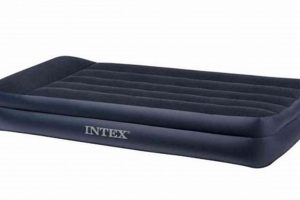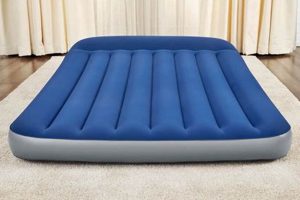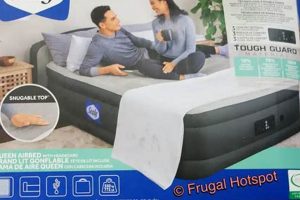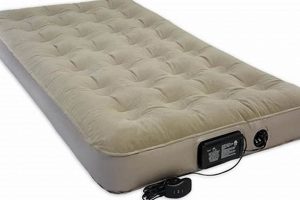A portable device utilizing battery power to inflate air mattresses represents a convenient solution for situations where access to standard electrical outlets is limited or unavailable. These devices typically employ a small electric motor to drive a pump mechanism, effectively drawing in ambient air and forcing it into the air mattress chamber until a desired firmness is achieved.
The value of such a device lies in its portability and ease of use, making it suitable for camping trips, guest accommodations in homes without readily accessible outlets, or emergency situations requiring rapid inflation. Historically, manual pumps were the primary method for inflating air mattresses, requiring significant physical effort. Battery-powered alternatives offer a substantial improvement in efficiency and convenience.
The following sections will delve into the operational principles, selection criteria, advantages, limitations, and maintenance requirements associated with these inflation devices. Understanding these aspects allows for informed decision-making when choosing a suitable device for specific needs and ensuring its longevity and optimal performance.
Optimizing Use of Portable Inflation Devices
Effective operation and longevity of these portable inflation devices necessitate adherence to specific guidelines and best practices. This section outlines critical considerations for maximizing performance and minimizing potential issues.
Tip 1: Battery Selection: Employing high-quality batteries significantly impacts inflation speed and device runtime. Alkaline or rechargeable batteries specifically designed for high-drain devices are recommended for optimal performance.
Tip 2: Pre-Inflation Inspection: Prior to commencing inflation, meticulously inspect the air mattress for any punctures, tears, or defects. Inflating a damaged mattress can overwork the device and potentially cause motor failure.
Tip 3: Proper Nozzle Attachment: Ensure the inflation nozzle is securely and correctly attached to the air mattress valve. A loose connection can result in air leakage and inefficient inflation.
Tip 4: Avoid Over-Inflation: Over-inflating an air mattress can place undue stress on the seams and material, leading to premature failure. Refer to the air mattress manufacturer’s recommendations for optimal inflation levels.
Tip 5: Ambient Temperature Considerations: Extreme temperatures can affect battery performance and the elasticity of the air mattress material. Avoid using the device in excessively hot or cold environments.
Tip 6: Cleaning and Storage: After each use, clean the device and store it in a dry, protected environment. Remove batteries for prolonged storage to prevent corrosion and potential damage.
Tip 7: Consider Duty Cycle: Most portable inflation devices have a limited duty cycle. Avoid continuous operation for extended periods to prevent overheating and motor damage. Allow the device to cool down between inflation cycles.
Adherence to these guidelines will enhance the performance and extend the lifespan of the portable inflation device, ensuring reliable operation when required.
The subsequent sections will provide a comprehensive overview of troubleshooting common issues and explore the available warranty options for these devices.
1. Portability
The inherent value of a battery-operated air pump for an air mattress is inextricably linked to its portability. The device’s ability to operate independently of a fixed power source directly enables its use in locations lacking electrical infrastructure, such as campgrounds, remote worksites, or during power outages. Without effective portability, the practical application of such a device is severely constrained. The lightweight construction and compact form factor of many models are deliberate design choices to maximize ease of transport and storage.
Consider a family camping trip. A standard, electrically powered air pump would be rendered useless without access to a generator or electrical hookup. A battery-operated model, however, can readily inflate air mattresses within a tent or designated camping area, providing a comfortable sleeping surface irrespective of the availability of mains power. Similarly, humanitarian aid organizations often utilize these devices in disaster relief scenarios where rapid deployment of temporary shelters with air mattresses is crucial; portability becomes a paramount consideration for efficient operation. This highlights the criticality of portability in extending the operational scope of the device.
In summary, the relationship between a battery-operated air pump and portability is one of fundamental interdependence. Portability is not merely a desirable attribute; it is an essential characteristic that defines the device’s utility and broadens its applicability across diverse scenarios. Challenges remain in further reducing size and weight while simultaneously enhancing battery life and inflation power, but ongoing technological advancements continue to address these limitations, reinforcing the importance of this attribute.
2. Inflation Speed
Inflation speed, as a performance metric, significantly influences the practical utility of a battery-operated air pump for air mattresses. A device’s ability to rapidly inflate an air mattress directly affects user convenience, particularly in situations where time is a constraint. The relationship between these two elements warrants a detailed examination of contributing factors and their implications.
- Motor Power and Airflow
The power of the internal electric motor directly correlates with the volume of air the pump can displace per unit time. More powerful motors generally facilitate higher airflow rates, leading to faster inflation. However, increased motor power also typically translates to higher energy consumption, potentially reducing battery life. Therefore, manufacturers strive to achieve a balance between inflation speed and energy efficiency.
- Pump Mechanism Efficiency
The design and efficiency of the pumping mechanism are critical. Diaphragm pumps, piston pumps, and turbine-based designs each exhibit varying degrees of efficiency in converting motor energy into airflow. A more efficient pump mechanism requires less energy to deliver the same volume of air, thus contributing to both faster inflation and extended battery runtime.
- Nozzle and Valve Compatibility
The design of the inflation nozzle and its compatibility with the air mattress valve influence airflow resistance. A poorly designed nozzle or an incompatible valve can restrict airflow, significantly increasing inflation time. Universally compatible nozzle designs or adapters that accommodate various valve ty
pes are crucial for maximizing inflation speed across different air mattress models. - Battery Capacity and Output
The capacity of the battery and its ability to deliver sufficient current to the motor are essential determinants of inflation speed. A battery with inadequate capacity or a limited output current will constrain the motor’s performance, resulting in slower inflation. High-capacity batteries capable of sustaining high current draw are necessary for optimal inflation speeds, particularly when inflating larger air mattresses.
In conclusion, the inflation speed of a battery-operated air pump for air mattresses is a multifaceted characteristic determined by the interplay of motor power, pump mechanism efficiency, nozzle/valve compatibility, and battery performance. While rapid inflation is desirable, it must be balanced with considerations of energy efficiency and device longevity. Understanding these interconnected factors allows for a more informed assessment of a given device’s overall suitability for specific needs and applications.
3. Battery Life
The operational effectiveness of a battery operated air pump for air mattresses is fundamentally contingent upon its battery life. This aspect determines the number of inflation cycles the device can perform before requiring battery replacement or recharging, directly impacting its practicality in situations where access to power sources is limited. A shorter battery life restricts the device’s utility, particularly during camping trips, emergency situations, or guest accommodations where convenient power access is not guaranteed.
For instance, consider an individual using the device to inflate an air mattress daily for a guest. A pump with a low battery capacity might require frequent battery replacements, increasing operational costs and reducing convenience. Conversely, a device with extended battery life allows for multiple inflations on a single charge, proving advantageous for multi-day camping excursions or emergency preparedness kits. Furthermore, the type of battery significantly influences performance. Rechargeable lithium-ion batteries generally offer higher energy density and longer lifecycles than standard alkaline batteries, contributing to a more sustainable and cost-effective solution in the long term.
In conclusion, battery life stands as a critical performance parameter that directly correlates with the usefulness and cost-effectiveness of a battery operated air pump for air mattresses. Addressing limitations in battery technology, such as increasing energy density and reducing recharge times, will further enhance the appeal and practicality of these devices, solidifying their role in various portable inflation applications. Manufacturers are continually innovating to improve battery management and optimize energy consumption, addressing this core requirement.
4. Nozzle Compatibility
Nozzle compatibility represents a critical, yet often overlooked, aspect of battery-operated air pumps intended for air mattress inflation. The effectiveness and usability of such a pump are directly contingent upon its ability to securely and efficiently connect to the air valve of the target air mattress. Variations in air valve designs necessitate careful consideration of nozzle compatibility to ensure proper function and prevent air leakage.
- Universal Adapters
Many battery-operated air pumps incorporate a set of universal adapters designed to accommodate a range of air valve types commonly found on air mattresses. These adapters may include tapered nozzles, pinch-valve connectors, and threaded fittings. The inclusion of such adapters expands the pump’s versatility, enabling it to function with multiple air mattress brands and models. The absence of suitable adapters can render the pump unusable with certain air mattresses, limiting its overall value.
- Secure Connection Mechanisms
A secure connection between the nozzle and the air valve is paramount to prevent air leakage during inflation. Nozzles with integrated locking mechanisms, such as twist-lock or snap-fit designs, offer a more reliable seal compared to simple friction-fit connections. Air leakage not only prolongs the inflation process but also places additional strain on the pump motor, potentially reducing its lifespan and battery runtime. A robust and leak-proof connection is, therefore, essential for efficient operation.
- Material Durability and Compatibility
The material composition of the nozzle plays a crucial role in its durability and compatibility with different air valve materials. Nozzles constructed from rigid plastics may be susceptible to cracking or breaking under pressure or stress, while nozzles made from flexible materials may deform or become detached during inflation. Compatibility between the nozzle material and the air valve material is also important to prevent chemical reactions or material degradation over time. Durable and chemically inert nozzle materials are preferable for ensuring long-term reliability.
- Inflation Efficiency
The design of the nozzle orifice and its alignment with the air valve can significantly influence the efficiency of the inflation process. A nozzle with a restricted orifice may impede airflow, increasing inflation time and energy consumption. Conversely, a properly designed nozzle that allows for unrestricted airflow can optimize inflation speed and minimize battery drain. Careful attention to nozzle design is, therefore, essential for maximizing the overall efficiency of the battery-operated air pump.
In conclusion, nozzle compatibility is a multifaceted consideration that directly impacts the performance and usability of a battery-operated air pump for air mattresses. From the inclusion of universal adapters to the implementation of secure connection mechanisms and the selection of durable materials, each aspect of nozzle design plays a crucial role in ensuring efficient and reliable inflation. Neglecting nozzle compatibility can result in frustration, reduced performance, and ultimately, a diminished user experience.
5. Airflow Volume
Airflow volume, measured in units such as cubic feet per minute (CFM) or liters per minute (LPM), constitutes a primary performance indicator for battery-operated air pumps designed for inflating air mattresses. A higher airflow volume signifies the pump’s capacity to move a greater quantity of air within a given timeframe, directly impacting the inflation speed of the air mattress. The relationship between airflow volume and inflation time is inversely proportional; a doubling of airflow volume, under ideal conditions, theoretically halves the inflation time. This connection is crucial for user convenience, especially in situations where rapid setup is required, such as camping or accommodating unexpected guests. An insufficient airflow volume results in prolonged inflation times, diminishing the user experience and potentially placing undue strain on the pump’s motor and battery.
The practical significance of airflow volume extends beyond mere convenience. In the context of emergency preparedness, a pump with a substantial
airflow volume enables the swift inflation of multiple air mattresses, facilitating the establishment of temporary shelters for displaced individuals. Conversely, a pump with a low airflow volume may prove inadequate for such tasks, hindering relief efforts. Furthermore, the physical size and power consumption of the pump often correlate with its airflow volume. More powerful pumps, capable of delivering higher airflow volumes, generally require larger batteries and may be less portable than their lower-volume counterparts. Therefore, the selection of an appropriate battery-operated air pump necessitates a careful consideration of the trade-offs between airflow volume, portability, battery life, and intended application. Manufacturers often specify the airflow volume of their pumps to allow consumers to make informed decisions based on their specific requirements.
In summary, airflow volume is an essential attribute determining the efficiency and suitability of a battery-operated air pump for air mattress inflation. Its impact on inflation speed and overall utility underscores its importance in various scenarios, ranging from recreational camping to emergency response. Selecting a pump with an appropriate airflow volume requires a balanced assessment of user needs, pump characteristics, and prevailing operational constraints. Challenges remain in optimizing the airflow volume while minimizing power consumption and maintaining a compact form factor, but ongoing technological advancements continue to refine pump designs and enhance their performance capabilities.
6. Durability
The longevity and reliability of a battery operated air pump for air mattresses are intrinsically linked to its durability. This attribute dictates the device’s ability to withstand repeated use, transportation, and exposure to varying environmental conditions without experiencing performance degradation or outright failure. A durable pump offers a greater return on investment by minimizing the need for frequent replacements, thereby reducing long-term costs and environmental impact. The inherent portability of these devices necessitates a robust construction capable of withstanding the rigors of travel, including potential impacts, vibrations, and exposure to dust or moisture.
Material selection plays a critical role in determining durability. High-impact plastics, reinforced housings, and corrosion-resistant components contribute to the pump’s ability to endure harsh conditions. For example, a pump used regularly at campsites might encounter rough handling, exposure to sunlight, and temperature fluctuations. A durable model, constructed with resilient materials, will continue to function reliably under these circumstances, whereas a less durable pump might succumb to cracks, component failures, or diminished performance. Similarly, the design and construction of the internal motor and pumping mechanism directly impact durability. A robust motor with quality bearings and a well-engineered pumping system can withstand prolonged operation and repeated start-stop cycles, ensuring consistent performance over an extended lifespan. This is exemplified in situations where the pump is used to inflate multiple air mattresses in quick succession; a durable motor will resist overheating and maintain consistent airflow, while a weaker motor may falter or fail.
In summary, durability is a paramount characteristic that significantly enhances the value and practicality of a battery operated air pump for air mattresses. Selecting a durable model, constructed with quality materials and a robust design, ensures long-term reliability, reduced maintenance costs, and consistent performance under diverse operating conditions. While initial cost may be a factor, the long-term benefits of durability outweigh the short-term savings associated with less robust alternatives, establishing durability as a key criterion for informed purchasing decisions.
7. Noise Level
Noise level, measured in decibels (dB), represents a significant consideration in the selection and use of battery-operated air pumps for air mattresses. The operational noise generated by these devices can impact user comfort, disturb sleeping environments, and potentially violate noise ordinances in certain locations. Understanding the factors contributing to noise level and their implications is essential for informed decision-making.
- Motor Type and Design
The type and design of the electric motor employed in the air pump directly influence its noise output. Motors with poorly balanced armatures, loose components, or inadequate vibration dampening tend to generate higher noise levels. Brushless motors, while generally more efficient, can still produce significant noise if not properly engineered. The motor’s operating speed also contributes; higher speeds typically correlate with increased noise.
- Pump Mechanism Operation
The mechanism by which the air pump draws and compresses air, such as a diaphragm, piston, or rotary vane system, is a primary source of noise. Reciprocating mechanisms, like piston pumps, inherently generate more noise due to the oscillating motion of their components. Diaphragm pumps, while often quieter, can still produce noticeable noise from the flexing of the diaphragm material. The design and material composition of these components significantly affect noise generation.
- Housing Material and Construction
The material and construction of the air pump’s housing play a crucial role in sound dampening. Lightweight plastic housings tend to amplify noise, while denser materials, such as reinforced composites or metal enclosures, can effectively absorb and reduce noise transmission. The presence of sound-absorbing materials within the housing further contributes to noise reduction by minimizing internal reflections and vibrations.
- Operating Environment and Proximity
The surrounding environment and the proximity of individuals to the operating air pump influence the perceived noise level. Hard, reflective surfaces can amplify sound, while soft, absorbent materials dampen it. Using the pump on a carpeted surface or placing it on a soft cloth can reduce noise transmission. Furthermore, the perceived loudness of the noise decreases with increasing distance from the source. Therefore, operating the pump in a well-insulated room or at a distance from sleeping areas can mitigate the impact of its noise output.
The multifaceted nature of noise generation in battery-operated air pumps necessitates a holistic approach to noise mitigation. Selecting a pump with a low noise rating, employing sound-dampening techniques, and considering the operating environment are all important factors in minimizing noise disturbance. While complete silence may not be achievable, careful consideration of these elements can significantly enhance the user experience and minimize the potential for noise-related complaints.
Frequently Asked Questions
This section addresses common inquiries regarding the functionality, maintenance, and selection of battery-operated air pumps designed for inflating air mattresses.
Question 1: What is the expected operational lifespan of a battery-operated air pump for air mattresses?
The operational lifespan is contingent upon usage frequency, environmental conditions, and adherence to manufacturer guidelines. High-quality pumps, when properly maintaine
d, can function effectively for several years. Overloading the pump, operating it in extreme temperatures, or neglecting cleaning can significantly reduce its lifespan.
Question 2: How should one determine the appropriate battery type for a given battery-operated air pump?
The pump’s instruction manual specifies the required battery type. Employing batteries outside the recommended specifications can result in diminished performance, pump damage, or potential safety hazards. Alkaline or rechargeable batteries, depending on the model, are typically utilized. Verify voltage and amperage requirements prior to battery installation.
Question 3: What measures should be taken to prevent overheating during extended pump operation?
Most battery-operated air pumps possess a limited duty cycle. Continuous operation beyond this cycle can lead to overheating and potential motor damage. Allowing the pump to cool down for a period equal to the operational time is advisable. Monitoring the pump’s temperature during use and ceasing operation if it becomes excessively hot can prevent overheating.
Question 4: How does altitude affect the performance of a battery-operated air pump?
At higher altitudes, the air density is lower, which can impact the pump’s efficiency. It may take longer to inflate an air mattress at high altitudes compared to sea level. Some advanced pumps feature altitude adjustment settings to compensate for this effect. However, the performance reduction is generally marginal for most consumer-grade pumps.
Question 5: What are the typical symptoms of a failing battery-operated air pump?
Common symptoms include reduced airflow, unusual noises during operation, overheating, intermittent functionality, and premature battery depletion. These symptoms may indicate a failing motor, damaged components, or a clogged air intake. Discontinuing use and seeking professional repair or replacement is recommended.
Question 6: Is it safe to operate a battery-operated air pump in wet or humid conditions?
Exposure to excessive moisture can compromise the pump’s electrical components and pose a safety risk. Many pumps are not designed for operation in wet conditions. Refer to the manufacturer’s instructions for specific guidelines. Employing a waterproof cover or operating the pump in a dry environment is advisable to prevent water damage.
The preceding questions and answers offer essential guidance for the responsible and effective utilization of these inflation devices. Understanding these considerations facilitates informed usage and promotes the longevity of the equipment.
The next section will provide a comparative analysis of various battery-operated air pump models currently available on the market.
Conclusion
This exploration has elucidated the multifaceted aspects of the battery operated air pump for air mattress, underscoring its significance as a portable inflation solution. Key elements such as portability, inflation speed, battery life, nozzle compatibility, airflow volume, durability, and noise level have been examined, revealing their individual and collective contributions to the device’s overall utility and user experience. The analysis has also highlighted frequently encountered operational challenges and provided guidance for optimal utilization and maintenance.
Ultimately, the selection and responsible employment of a battery operated air pump for air mattress necessitate a discerning evaluation of specific needs and operational context. Continued advancements in battery technology, motor efficiency, and material science hold the promise of further enhancing the performance, reliability, and environmental sustainability of these devices, solidifying their role in diverse scenarios ranging from recreational activities to emergency preparedness. Therefore, a comprehensive understanding of the attributes discussed remains paramount for informed decision-making and maximizing the benefits derived from this portable inflation technology.







